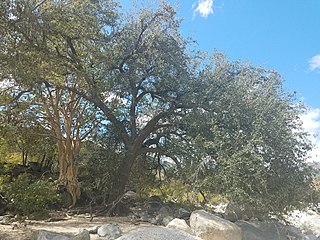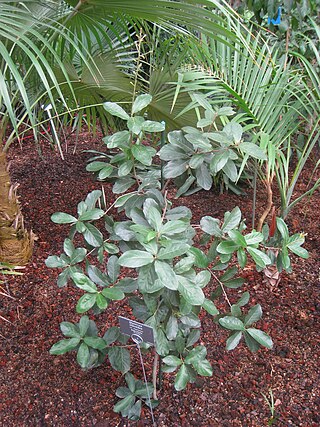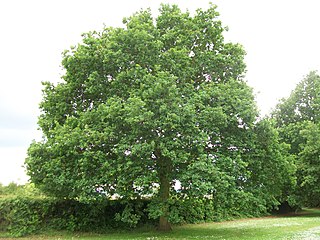Related Research Articles

Chaparral is a shrubland plant community found primarily in California, in southern Oregon and in the northern portion of the Baja California Peninsula in Mexico. It is shaped by a Mediterranean climate and infrequent, high-intensity crown fires.

An oak is a tree or shrub in the genus Quercus of the beech family, Fagaceae. There are approximately 500 extant species of oaks. The common name "oak" also appears in the names of species in related genera, notably Lithocarpus, as well as in those of unrelated species such as Grevillea robusta and the Casuarinaceae (she-oaks). The genus Quercus is native to the Northern Hemisphere and includes deciduous and evergreen species extending from cool temperate to tropical latitudes in the Americas, Asia, Europe, and North Africa. North America has the largest number of oak species, with approximately 160 species in Mexico, of which 109 are endemic and about 90 in the United States. The second greatest area of oak diversity is China, with approximately 100 species.

Quercus robur, the pedunculate oak, is a species of flowering plant in the beech and oak family, Fagaceae. It is a large tree, native to most of Europe and western Asia, and is widely cultivated in other temperate regions. It grows on soils of near neutral acidity in the lowlands and is notable for its value to natural ecosystems, supporting a very wide diversity of herbivorous insects and other pests, predators and pathogens.

Quercus ilex, the evergreen oak, holly oak or holm oak is a large evergreen oak native to the Mediterranean region. It is a member of the Ilex section of the genus, with acorns that mature in a single summer.

Quercus douglasii, known as blue oak, is a species of oak endemic to California, common in the Coast Ranges and the foothills of the Sierra Nevada. It is California's most drought-tolerant deciduous oak, and is a dominant species in the blue oak woodland ecosystem. It is occasionally known as mountain oak and iron oak.

Quercus tomentella, the island oak, island live oak, or Channel Island oak, is an oak in the section Protobalanus. It is native to six islands: five of the Channel Islands of California and Guadalupe Island, part of Baja California.

Quercus lobata, commonly called the valley oak or roble, grows into the largest of California oaks. It is endemic to California, growing in interior valleys and foothills from Siskiyou County to San Diego County. Mature specimens may attain an age of up to 600 years. This deciduous oak requires year-round access to groundwater.

Quercus brandegeei is a rare Mexican species of plant in the family Fagaceae, in the oak genus Quercus, section Virentes. It has been found only in the southern part of the State of Baja California Sur in northwestern Mexico.

Quercus × macdonaldii, formerly Quercus macdonaldii, with the common names MacDonald's oak and Macdonald oak, is a rare hybrid species of oak in the family Fagaceae.
Forest migration or assisted migration is the movement of large seed plant dominated communities in geographical space over time.

The California coastal sage and chaparral is a Mediterranean forests, woodlands, and scrub ecoregion located in southwestern California and northwestern Baja California (Mexico). It is part of the larger California chaparral and woodlands ecoregion.

Quercus geminata, commonly called sand live oak, is an evergreen oak tree native to the coastal regions of the subtropical southeastern United States, along the Atlantic Coast from southern Florida northward to southeastern Virginia and along the Gulf Coast westward to southern Mississippi, on seacoast dunes and on white sands in evergreen oak scrubs.

Quercus sagrana, also spelt Quercus sagraeana, the Cuban oak, is a medium-sized evergreen tree native to western Cuba in the Cuban pine forests ecoregion. It is the only oak native to the Caribbean.

Andricus quercuscalifornicus, or the California gall wasp, is a small wasp species that induces oak apple galls on white oaks, primarily the Valley Oak but also other species such as Quercus berberidifolia. The California gall wasp is considered an ecosystem engineer, capable of manipulating the growth of galls for their own development. It is found from Washington, Oregon, and California to northern regions of Mexico. Often multiple wasps in different life stages occupy the same gall. The induced galls help establish complex insect communities, promoting the diversification in niche differentiation. Furthermore, the adaptive value of these galls could be attributed their ecological benefits such as nutrition, provision of microenvironment, and enemy avoidance.

Ramalina menziesii, the lace lichen or fishnet, is a pale yellowish-green to grayish-green foliose lichen. It grows up to a meter long, hanging from bark and twigs in a distinctive net-like or lace-like pattern that is unlike any other lichen in North America. It becomes a deeper green when wet. Apothecia are lecanorine. it is an important food source for deer in the Coast Range of California, and a source of nest material for birds. It is highly variable in its growth form, with branches sometimes so slender as to appear like strands, sometimes tiny, and sometimes large with broadly flattened branches.
Ruth Geyer Shaw is a professor and principal investigator in the Department of Ecology, Evolution and Behavior at the University of Minnesota. She studies the processes involved in genetic variation, specializing in plant population biology and evolutionary quantitative genetics. Her work is particularly relevant in studying the effects of stressors such as climate instability and population fragmentation on evolutionary change in populations. She has developed and applied new statistical methods for her field and is considered a leading population geneticist.
Landscape genomics is one of many strategies used to identify relationships between environmental factors and the genetic adaptation of organisms in response to these factors. Landscape genomics combines aspects of landscape ecology, population genetics and landscape genetics. The latter addresses how landscape features influence the population structure and gene flow of organisms across time and space. The field of landscape genomics is distinct from landscape genetics in that it is not focused on the neutral genetic processes, but considers, in addition to neutral processes such as drift and gene flow, explicitly adaptive processes, i.e. the role of natural selection.

Landscape genetics is the scientific discipline that combines population genetics and landscape ecology. It broadly encompasses any study that analyses plant or animal population genetic data in conjunction with data on the landscape features and matrix quality where the sampled population lives. This allows for the analysis of microevolutionary processes affecting the species in light of landscape spatial patterns, providing a more realistic view of how populations interact with their environments. Landscape genetics attempts to determine which landscape features are barriers to dispersal and gene flow, how human-induced landscape changes affect the evolution of populations, the source-sink dynamics of a given population, and how diseases or invasive species spread across landscapes.
Jeannine Cavender-Bares is a Distinguished McKnight University Professor at the University of Minnesota in the Department of Ecology, Evolution & Behavior. Her research integrates evolutionary biology, ecology, and physiology by studying the functional traits of plants, with a particular focus on oaks.

Quercus subgenus Quercus is one of the two subgenera into which the genus Quercus was divided in a 2017 classification. It contains about 190 species divided among five sections. It may be called the New World clade or the high-latitude clade; most species are native to the Americas, the others being found in Eurasia and northernmost North Africa.
References
- 1 2 Victoria Sork publications indexed by Google Scholar
- ↑ Sork, Victoria L.; Nason, John; Campbell, Diane R.; Fernandez, Juan F. (1999). "Landscape approaches to historical and contemporary gene flow in plants". Trends in Ecology & Evolution. 14 (6): 219–224. doi:10.1016/S0169-5347(98)01585-7. ISSN 0169-5347. PMID 10354623.
- ↑ Loiselle, Bette A.; Sork, Victoria L.; Nason, John; Graham, Catherine (1995). "Spatial genetic structure of a tropical understory shrub, Psychotria officinalis (Rubiaceae)". American Journal of Botany. 82 (11): 1420–1425. doi:10.1002/j.1537-2197.1995.tb12679.x. ISSN 0002-9122.
- ↑ Kelly, Dave; Sork, Victoria L. (2002). "Mast Seeding in Perennial Plants: Why, How, Where?". Annual Review of Ecology and Systematics. 33 (1): 427–447. doi:10.1146/annurev.ecolsys.33.020602.095433. ISSN 0066-4162.
- ↑ Sork, Victoria L.; Bramble, Judy; Sexton, Owen (1993). "Ecology of Mast-Fruiting in Three Species of North American Deciduous Oaks". Ecology. 74 (2): 528–541. doi:10.2307/1939313. ISSN 0012-9658. JSTOR 1939313.
- 1 2 3 4 "Victoria L. Sork". lifesciences.ucla.edu. UCLA. Retrieved 2020-02-02.
- ↑ Regents, University of Michigan Board of (1972). Proceedings. The University.[ ISBN missing ]
- ↑ Sork, Victoria Louise (1979). Demographic Consequences of Mammalian Seed Dispersal for Pignut Hickory (PhD thesis). University of Michigan. OCLC 5822016. ProQuest 302924856.
- 1 2 "Research in the Sork Lab". sorklab.eeb.ucla.edu. Retrieved 2020-02-02.
- ↑ "Victoria Sork". Institute of the Environment and Sustainability at UCLA. 2016-09-22. Retrieved 2020-02-03.
- 1 2 3 "Department of Ecology and Evolutionary Biology | indivFaulty2". eeb.ucla.edu. Retrieved 2020-02-02.
- ↑ "Valley oak tree could provide insight into how plants will adapt to climate change". dailybruin.com. Retrieved 2020-02-03.
- ↑ Browne, Luke; Wright, Jessica W.; Fitz-Gibbon, Sorel; Gugger, Paul F.; Sork, Victoria L. (2019). "Adaptational lag to temperature in valley oak (Quercus lobata) can be mitigated by genome-informed assisted gene flow". Proceedings of the National Academy of Sciences. 116 (50): 25179–25185. Bibcode:2019PNAS..11625179B. doi: 10.1073/pnas.1908771116 . ISSN 0027-8424. PMC 6911187 . PMID 31767740.
- 1 2 3 4 5 6 Colgan, David (2019-11-25). "One of California's iconic tree species offers lessons for conservation".
{{cite journal}}: Cite journal requires|journal=(help) - ↑ Kinver, Mark (2019-12-05). "Genetics can play key role in saving trees". BBC News. Retrieved 2020-02-03.
- ↑ Browne, Luke; Wright, Jessica W.; Fitz-Gibbon, Sorel; Gugger, Paul F.; Sork, Victoria L. (2019-12-10). "Adaptational lag to temperature in valley oak (Quercus lobata) can be mitigated by genome-informed assisted gene flow". Proceedings of the National Academy of Sciences. 116 (50): 25179–25185. Bibcode:2019PNAS..11625179B. doi: 10.1073/pnas.1908771116 . ISSN 0027-8424. PMC 6911187 . PMID 31767740.
- ↑ Wolpert, Stuart; UCLA (2019-08-14). "UCLA to lead $10 million California conservation project". universityofcalifornia.edu. University of California. Retrieved 2020-02-02.
- ↑ Women, UCLA Center for the Study of (2013-02-01). "Victoria Sork". escholarship.org.
- ↑ "$5 million gift from Morton La Kretz will support renovation of UCLA Botany Building". UCLA. Retrieved 2020-02-03.
- ↑ "UCLA's Mildred E. Mathias Botanical Garden is ready for its close-up". UCLA. Retrieved 2020-02-03.
- ↑ "Annual report" (PDF). www.aaas.org. 2004. Retrieved 2020-02-03.
- ↑ "Victoria Sork awarded the 2020 Molecular Ecology Prize". 4 May 2020.